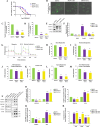Defects of mitochondria-lysosomes communication induce secretion of mitochondria-derived vesicles and drive chemoresistance in ovarian cancer cells
- PMID: 38448982
- PMCID: PMC10916030
- DOI: 10.1186/s12964-024-01507-y
Defects of mitochondria-lysosomes communication induce secretion of mitochondria-derived vesicles and drive chemoresistance in ovarian cancer cells
Abstract
Background: Among the mechanisms of mitochondrial quality control (MQC), generation of mitochondria-derived vesicles (MDVs) is a process to avoid complete failure of mitochondria determining lysosomal degradation of mitochondrial damaged proteins. In this context, RAB7, a late endocytic small GTPase, controls delivery of MDVs to late endosomes for subsequent lysosomal degradation. We previously demonstrated that RAB7 has a pivotal role in response to cisplatin (CDDP) regulating resistance to the drug by extracellular vesicle (EVs) secretion.
Methods: Western blot and immunofluorescence analysis were used to analyze structure and function of endosomes and lysosomes in CDDP chemosensitive and chemoresistant ovarian cancer cell lines. EVs were purified from chemosensitive and chemoresistant cells by ultracentrifugation or immunoisolation to analyze their mitochondrial DNA and protein content. Treatment with cyanide m-chlorophenylhydrazone (CCCP) and RAB7 modulation were used, respectively, to understand the role of mitochondrial and late endosomal/lysosomal alterations on MDV secretion. Using conditioned media from chemoresistant cells the effect of MDVs on the viability after CDDP treatment was determined. Seahorse assays and immunofluorescence analysis were used to study the biochemical role of MDVs and the uptake and intracellular localization of MDVs, respectively.
Results: We observed that CDDP-chemoresistant cells are characterized by increased MDV secretion, impairment of late endocytic traffic, RAB7 downregulation, an increase of RAB7 in EVs, compared to chemosensitive cells, and downregulation of the TFEB-mTOR pathway overseeing lysosomal and mitochondrial biogenesis and turnover. We established that MDVs can be secreted rather than delivered to lysosomes and are able to deliver CDDP outside the cells. We showed increased secretion of MDVs by chemoresistant cells ultimately caused by the extrusion of RAB7 in EVs, resulting in a dramatic drop in its intracellular content, as a novel mechanism to regulate RAB7 levels. We demonstrated that MDVs purified from chemoresistant cells induce chemoresistance in RAB7-modulated process, and, after uptake from recipient cells, MDVs localize to mitochondria and slow down mitochondrial activity.
Conclusions: Dysfunctional MQC in chemoresistant cells determines a block in lysosomal degradation of MDVs and their consequent secretion, suggesting that MQC is not able to eliminate damaged mitochondria whose components are secreted becoming effectors and potential markers of chemoresistance.
Keywords: Cisplatin chemoresistance; Extracellular vesicles; Mitochondria-derived vesicles; Ovarian cancer; RAB7.
© 2024. The Author(s).
Conflict of interest statement
The authors declare no competing interests.
Figures











Similar articles
-
Induced mitochondrial deficit by NDUFS3 transient silencing reduces RAB7 expression and causes lysosomal dysfunction in pancreatic cancer cells.Cell Commun Signal. 2025 May 14;23(1):224. doi: 10.1186/s12964-025-02214-y. Cell Commun Signal. 2025. PMID: 40369571 Free PMC article.
-
[Inhibition of mitochondrial Smac release by Akt in chemoresistant ovarian cancer cells].Zhonghua Zhong Liu Za Zhi. 2008 Apr;30(4):259-62. Zhonghua Zhong Liu Za Zhi. 2008. PMID: 18788627 Chinese.
-
Mitochondria break free: Mitochondria-derived vesicles in aging and associated conditions.Ageing Res Rev. 2024 Dec;102:102549. doi: 10.1016/j.arr.2024.102549. Epub 2024 Oct 19. Ageing Res Rev. 2024. PMID: 39427885 Review.
-
Role of the RAB7 Protein in Tumor Progression and Cisplatin Chemoresistance.Cancers (Basel). 2019 Aug 1;11(8):1096. doi: 10.3390/cancers11081096. Cancers (Basel). 2019. PMID: 31374919 Free PMC article. Review.
-
Modulation of RAB7A Protein Expression Determines Resistance to Cisplatin through Late Endocytic Pathway Impairment and Extracellular Vesicular Secretion.Cancers (Basel). 2019 Jan 8;11(1):52. doi: 10.3390/cancers11010052. Cancers (Basel). 2019. PMID: 30626032 Free PMC article.
Cited by
-
Extracellular Vesicles & Co.: scaring immune cells in the TME since ever.Front Immunol. 2024 Aug 29;15:1451003. doi: 10.3389/fimmu.2024.1451003. eCollection 2024. Front Immunol. 2024. PMID: 39267748 Free PMC article. Review.
-
The detection, biological function, and liquid biopsy application of extracellular vesicle-associated DNA.Biomark Res. 2024 Oct 14;12(1):123. doi: 10.1186/s40364-024-00661-2. Biomark Res. 2024. PMID: 39402599 Free PMC article. Review.
-
Dysfunctional Mitochondria Characterize Amyotrophic Lateral Sclerosis Patients' Cells Carrying the p.G376D TARDBP Pathogenetic Substitution.Antioxidants (Basel). 2025 Mar 28;14(4):401. doi: 10.3390/antiox14040401. Antioxidants (Basel). 2025. PMID: 40298692 Free PMC article.
-
Characterization of Chemoresistance in Pancreatic Cancer: A Look at MDR-1 Polymorphisms and Expression in Cancer Cells and Patients.Int J Mol Sci. 2024 Aug 4;25(15):8515. doi: 10.3390/ijms25158515. Int J Mol Sci. 2024. PMID: 39126083 Free PMC article.
-
Mitochondria-derived vesicles: A promising and potential target for tumour therapy.Clin Transl Med. 2025 May;15(5):e70320. doi: 10.1002/ctm2.70320. Clin Transl Med. 2025. PMID: 40356246 Free PMC article. Review.
References
Publication types
MeSH terms
Substances
Grants and funding
LinkOut - more resources
Full Text Sources
Medical
Miscellaneous

